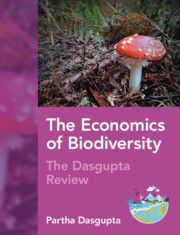Book contents
- The Economics of Biodiversity
- The Economics of Biodiversity
- Copyright page
- Contents
- List of Boxes
- Foreword
- Preface to the CUP Edition
- Preface
- Part I Foundations
- Chapter 0 How We Got to Where We Are
- Chapter 1 Nature as an Asset
- Chapter 2 Biodiversity and Ecosystem Services
- Chapter 3 Biospheric Disruptions
- Chapter 4 Human Impact on the Biosphere
- Chapter 4* The Bounded Global Economy
- Chapter 5 Risk and Uncertainty
- Chapter 6 Laws and Norms as Social Institutions
- Chapter 7 Human Institutions and Ecological Systems, 1: Unidirectional Externalities and Regulatory Policies
- Chapter 8 Human Institutions and Ecological Systems, 2:
- Chapter 8* Management of CPRs:
- Chapter 9 Human Institutions and Ecological Systems, 3:
- Chapter 10 Well-Being Across the Generations
- Chapter 11 The Content of Well-Being: Empirics
- Chapter 12 Valuing Biodiversity
- Chapter 13 Sustainability Assessment and Policy Analysis
- Chapter 13* Accounting Prices and Inclusive Wealth
- Part II Extensions
- Part III The Road Ahead
- Appendix
- Acronyms
- Glossary
- References
- Acknowledgements
- Author Index
- Subject Index
Chapter 8 - Human Institutions and Ecological Systems, 2:
Common Pool Resources
from Part I - Foundations
Published online by Cambridge University Press: 10 March 2025
- The Economics of Biodiversity
- The Economics of Biodiversity
- Copyright page
- Contents
- List of Boxes
- Foreword
- Preface to the CUP Edition
- Preface
- Part I Foundations
- Chapter 0 How We Got to Where We Are
- Chapter 1 Nature as an Asset
- Chapter 2 Biodiversity and Ecosystem Services
- Chapter 3 Biospheric Disruptions
- Chapter 4 Human Impact on the Biosphere
- Chapter 4* The Bounded Global Economy
- Chapter 5 Risk and Uncertainty
- Chapter 6 Laws and Norms as Social Institutions
- Chapter 7 Human Institutions and Ecological Systems, 1: Unidirectional Externalities and Regulatory Policies
- Chapter 8 Human Institutions and Ecological Systems, 2:
- Chapter 8* Management of CPRs:
- Chapter 9 Human Institutions and Ecological Systems, 3:
- Chapter 10 Well-Being Across the Generations
- Chapter 11 The Content of Well-Being: Empirics
- Chapter 12 Valuing Biodiversity
- Chapter 13 Sustainability Assessment and Policy Analysis
- Chapter 13* Accounting Prices and Inclusive Wealth
- Part II Extensions
- Part III The Road Ahead
- Appendix
- Acronyms
- Glossary
- References
- Acknowledgements
- Author Index
- Subject Index
Summary
In the absence of collective action, the use of the biosphere’s goods and services gives rise to an important class of reciprocal externalities. The externalities are most powerful when access to a resource base, which may be an entire ecosystem, is unrestricted. Today, the most prominent among open access resources are the atmosphere as a sink for gaseous and particle emissions, and the oceans beyond the 200-mile exclusive economic zones (EEZs) of nations.249 Anthropologists have discovered, however, that ecosystems with small geographical reach, such as village woodlands and ponds, are usually neither private property nor state property, but are instead communal property. In this chapter, we use the conceptual apparatus that was developed in Chapter 6 to provide a sense of the way communities in various parts of the world have tried to manage their local ecosystems. By so doing, we will gain an understanding of the successes and failures of societies to live within their local resource base.
- Type
- Chapter
- Information
- The Economics of BiodiversityThe Dasgupta Review, pp. 197 - 212Publisher: Cambridge University PressPrint publication year: 2024

